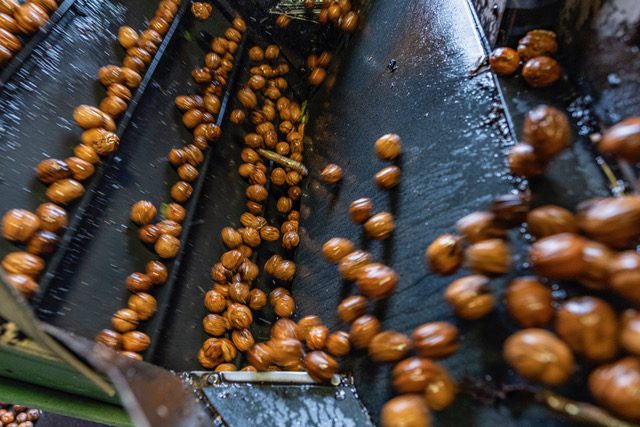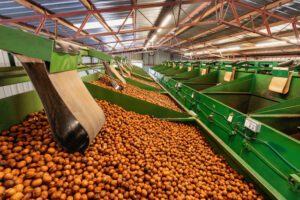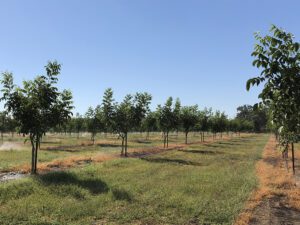
The California walnut industry isn’t going to pick up their marbles and go home.
Instead, after a couple tough years, there are goals and objectives in place to secure long term market resilience and grower prosperity.
Christine Lott, director of integrated communication for the California Walnut Commission (CWC), said the industry plan, put together with extensive grower and stakeholder input, has six priorities:
1. Delivering the best-quality product
2. Activating sales domestically and in target international markets
3. Fostering innovation
4. Defining our sustainability story
5. Supporting goal-oriented production and postharvest research
6. Building industry cohesion
“The California walnut industry as a whole identified key issues and challenges they face not only today but also in the future, and together with the [California Walnut Board and Commission] identified a host of corrective actions and priority areas for action in the short and long term, which some are already underway,” Lott said.
She added a focus of the industry is to provide the best walnuts all the way to the consumer, including better handling of walnuts through the supply chain, and continued demand-building initiatives that increase consumption and drive sales and velocity.
‘’We are working to make walnuts more relevant to consumers as a nut for everyday eating occasions. Working with retail partners, we are bringing visibility and excitement to walnuts in produce with expanded offerings of package size options, flavors and more walnut products in different forms, which research shows are key motivators to consumers. In addition, we are working in foodservice and food innovation to showcase the versatility of walnuts in many cuisines and dayparts.”
Priorities
The six priorities start with determination to deliver the best-quality product, with a new focus on addressing four significant contributors to improve walnut shelf life and reduce rancidity: color, chemical, transport and storage recommendations.
Handlers are experimenting with new automated visual grading machines to deliver standardized color measurements and reporting. Recommendations for best practices for transportation and storage and higher-quality standards were developed in 2023. This included recommended maximum limits for Peroxide Value and Free Fatty Acid and refrigeration guidance for walnut shipments and storage after May 1.
To increase sales domestically, CWC has invested in retail scan data to develop strategies to improve sales volumes of California walnuts at retail. The data will enable the monitoring of retail sales growth, develop promotional programs for retailers and share best practices in walnut merchandising with the goal of driving sales, larger display sizes and improved placement for fresh California walnuts at retail.
The industry is also working to expand distribution and sales globally. Earlier this year, CWC was awarded $7 million from USDA’s Regional Agriculture Promotions Program for export market development in countries in Southeast Asia and Northern Africa. This additional funding will allow the industry to expand programs into new markets as well as boost consumer and trade activities in core strategic export markets.
Lott said, “This additional funding will allow the industry to expand programs into new markets as well as boost consumer and trade activities in our core strategic export markets, with the overarching goal to drive distribution, consumer demand and consumption of high-quality California walnuts in more markets globally.”

Fostering Innovation
The intention in fostering innovation aims to drive commercialization of new product ideas and explore proof of concept for craveable products using California walnuts. Led by the California Walnut Board and CWC, they will provide leadership, build value and create opportunities for walnuts as a more valuable ingredient in food products for foodservice, culinary and in food manufacturing.
Measure to Improve, a firm that specializes in helping produce companies navigate sustainability, is assisting CWC in evaluating existing industry sustainability areas and identifying knowledge and data gaps. Work is planned to develop a sustainability index that will demonstrate the California walnut industry is dedicated to sustainable production.
Goal-oriented research is a shift by the industry to develop a new roadmap for walnut related production and postharvest research, aimed at solving challenges in the field, in processing and storage, and in the context of international market growth, which will enable improved quality, lowered costs and increased efficiencies. Several CWC-endorsed projects include USDA Specialty Crop grants being used to investigate conversion of walnut shells to high value prebiotic products for human health. UC Davis researchers are evaluating evapotranspiration estimation, comparing ground-based with satellite measurements to enhance water management. Another UC Davis project is implementing smart wireless technology to reduce chemical use in storage and preservation of product quality with early detection of insects.
Davin Norene, a Yuba-Sutter counties walnut grower, and participant in the commission’s strategic planning efforts, said CWC’s objectives are meant to engage every facet of the industry.
“Every part of the industry has a role to play in addressing these priorities,” Norene said.
“It starts with the growers, keeping up with technology, letting go of some older varieties. Growers can also be a face of the industry, tell their stories about walnut farming to the public,” he added.

Growers Involved
Growers can also be involved in the sustainability objective, telling consumers what they are already doing in their orchards and the benefits for their communities, workers and the environment.
These positive approaches are in contrast to a proposed orchard pullout program. There was some industry interest last year to seek funding for a program that would incentivize removal of orchards. However, CWC declined to pursue USDA funding for a tree removal program, believing pulling out highly productive walnut trees to reduce oversupply wasn’t in the best interest of the walnut industry.
Willows walnut grower Leslie Nerli noted decisions to pull out trees are extremely difficult and expensive to make but was relieved the program was not offered to growers as less productive orchards are already being removed.
“The only other thing to support our industry through these very tough times would be for growers to do business with handlers that have built the infrastructure to maintain the quality of the product all the way through the supply chain on a year-round basis.” Nerli said. “Those same handlers must also be investing in marketing efforts that tie directly with end consumers around the world, providing them with a consistent California-grown quality product in whatever form they desire. These handlers have spent a lot of money to make our industry strong now and for our future.”
Norene was optimistic as this year’s harvest began. Growers who farmed for yield and quality are expected to see better returns this year. Timed fertilizer applications and use of pressure chambers to determine when to irrigate can be helpful tools to maintain crop quality, he said. For growers watching input costs, well timed ethephon applications can help with uniform hull split.
“If you have harvest lined up, they can shake, sweep and pick up quick to preserve quality,” Noreen said.

Cecilia Parsons | Associate Editor
Cecilia Parsons has lived in the Central Valley community of Ducor since 1976, covering agriculture for numerous agricultural publications over the years. She has found and nurtured many wonderful and helpful contacts in the ag community, including the UCCE advisors, allowing for news coverage that focuses on the basics of food production.
She is always on the search for new ag topics that can help growers and processors in the San Joaquin Valley improve their bottom line.
In her free time, Cecilia rides her horse, Holly in ranch versatility shows and raises registered Shetland sheep which she exhibits at county and state fairs during the summer.















